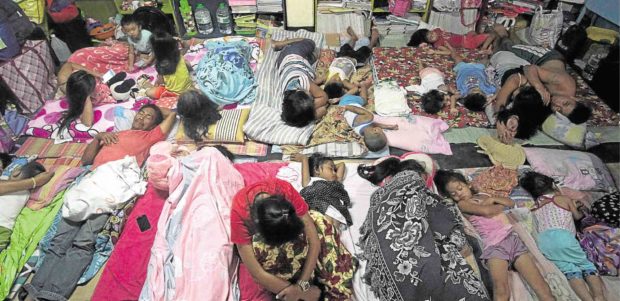
Families who left their villages as Mt. Mayon started spewing out ash and lava pack a classroom at Guinobatan East Central School in Guinobatan town, Albay province. —MARK ALVIC ESPLANA
LEGAZPI CITY—Fear and uncertainty have been driving residents of Albay province, even those outside danger zones, to leave their communities and seek shelter in evacuation centers as they await what volcanologists call as Mayon volcano’s hazardous eruption, disaster response and local officials said.
Cedric Daep, chief of the Albay Public Safety and Emergency Management Office, said people, including those living outside the 8-kilometer extended danger zone and the 9-km preemptive buffer zone in the southwest flank of the volcano, had been packing evacuation centers because they wanted to ensure the safety of their families once Mayon unleashed its fury.
Daep, citing the latest evacuation data, said 19,972 families or 76,757 people were staying in 73 evacuation centers in the towns of Daraga, Camalig, Guinobatan, Malilipot, Sto. Domingo and Bacacay, and the cities of Tabaco, Ligao and Legazpi.
The Philippine Institute of Volcanology and Seismology (Phivolcs) raised the alert level over Mayon to 4 (hazardous eruption imminent) on Monday when it started showing intense unrest and began spewing out ash plumes and lava.
Emergency
The government is bracing for a possible three-month-long emergency in areas around Mayon, said Romina Marasigan, spokesperson for the National Disaster Risk Reduction and Management Council, citing similar situations during previous eruptions of the volcano.
Displaced families may need to stay in evacuation centres for that long, she said.
Daep said local officials were expecting that the number of evacuees would exceed the number of people who evacuated in past eruptions of Mayon.
Lava fountains
Some 83,000 people were evacuated when Mayon erupted in 1984, while another 60,000 were displaced in its 1993 eruption, Daep said.
Volcanologists said there were seven more episodes of intense but sporadic lava fountaining at the crater lasting several minutes during a 21-hour period from Thursday morning.
The lava fountains, shooting up between 150 meters and 500 meters, generated ash plumes that spurted as high as 3 km above the crater, they said.
Paul Alanis, Phivolcs science and research specialist, said Mayon expelled 25 million cubic meters of lava since it erupted on Jan. 13.
But he said this volume was only 30 percent of what Mayon emitted in its 2009 eruption.
Pyroclastic flows were observed at the gullies leading to the Mi-isi, Lidong/Basud and Buyuan channels, Alanis said.
STARRY, FIERY NIGHT Tourists take advantage of a clear night sky to observe Mayon volcano’s lava flow from Quituinan Hills in Camalig town, Albay. This photo was taken at 11 p.m. on Thursday. —MARK ALVIC ESPLANA
Congestion
Antonio Ludovice Jr., provincial health officer, said congestion in evacuation centers, most of these school buildings, had led to health problems among evacuees.
Ludovice said a classroom could only house 50 people but their monitoring showed that some rooms were occupied by about 70 people.
“Of course, some diseases might be transmitted due to the number of people staying in one classroom. If we have to use more classrooms as shelters, we are going to displace children who are using these for learning,” he said.
Health officials recorded 2,823 health cases in evacuation centers from Jan. 15 to 25. Records showed that 1,222 evacuees were suffering from coughs and colds.
In a statement, Health Secretary Francisco Duque III said the Department of Health (DOH) had set up round-the-clock medical stations offering free consultations in every evacuation center in Albay.
He noted that those afflicted from bronchitis, emphysema or asthma should take extra precautions against exposure to volcanic ash, as this might cause even more health problems.
“We advise affected residents to minimize exposure to ash by staying indoors as much as possible, wear protective masks, goggles, wet towels against volcanic ash, keep doors and windows closed and observe road safety measures,” Duque said.
Fast lanes
Fast lanes in government hospitals have been created, with additional health workers ready to be sent to evacuation centers to provide emergency medical attention.
Food and other supplies remain adequate but concerns are growing over health and hygiene conditions at temporary shelters.
Health workers are giving free checkups and medicine to elderly women and children in evacuation centers, but there are not enough toilets.
“We are after the health of every evacuee, particularly those who are at high risk (the elderly and children) that they must be given medical attention [immediately] so their lives will not be in danger,” said Health Assistant Secretary Nestor Santiago Jr.
Dr. Napoleon Arevalo, DOH director in Bicol region, said the agency’s disease surveillance team was put on alert to attend to sick evacuees immediately. —REPORTS FROM MAR S. ARGUELLES, MA. APRIL MIER, MICHAEL B. JAUCIAN, DELFIN T. MALLARI JR., JULIE M. AURELIO AND REUTERS